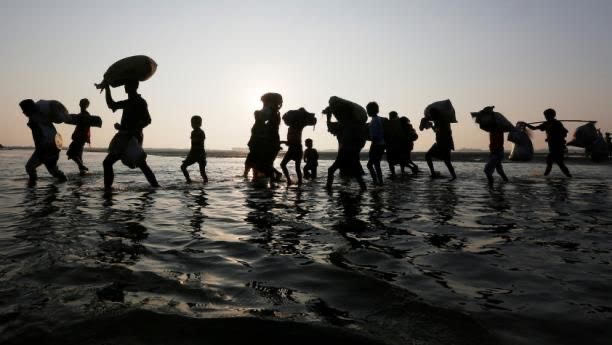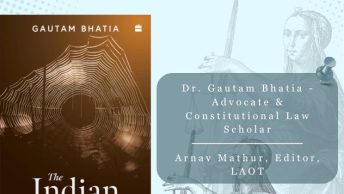India is not a signatory to the 1951 Refugee Convention but has historically adhered to international human rights principles. However, recent judicial responses, particularly the Supreme Court’s dismissal of pleas against deportation have sparked debate over the applicability of Articles 14 and 21 of the Constitution to refugees. As the country’s legal framework remains a patchwork of colonial-era statutes and executive discretion, the author analyses whether constitutional guarantees like equality and life can be truly realized for stateless people in the absence of a coherent refugee policy.
India has witnessed increase in influx of Rohingya Muslims refugees from the Rakhine state of Myanmar. Victims of long-standing persecution in their home country constitute one of the largest stateless populations in the world. towing to India’s porous border with Myanmar, there has been an increased refugee influx amounting to a staggering 40,000 Rohingyas living in India.
A recent petition Mohammad Ismail v. Union of India, it was alleged that several Rohingyas were abandoned and thrown into the seas after being taken by authorities on the pretext of recording their biometrics. The Special Rapporteur on the Human Rights in Myanmar has also launched a report, terming this treatment of Rohingya refugees “unconscionable” and “unacceptable.”
The Supreme Court’s dismissal of this petition has re-sparked the refugee rights debate. In Mohammad Salimullah v. Union of India, the Apex Court is already adjudging the scope of application of fundamental rights to refugees and the influence of international law principles over domestic laws and policies. While India is not a party to the 1951 Refugee Convention and its subsequent 1967 protocol, it has established several precedents reflecting its commitment to adhere to international humanitarian principles in dealing with this issue. Such commitments include compliance with procedural fairness, non-refoulement, and avoiding other forms of forced repatriation.
With the recent dismissal, the Supreme Court has taken a renewed approach towards the crisis by stating that although Articles 14 and 21 will apply to such persons, it does not extend to a right to stay or settle in India. In light of this revelation, a core question resurfaces- whether constitutional safeguards can be claimed by refugees when all India offers is a derisory patchwork of statutes in the garb of “refugee law.”
Article 14: an Apparition or an Aid?
The constitutional obligation conferred upon ‘non-citizens’ has remained unfulfilled in the context of refugees, particularly Rohingyas. While refusing to grant a stay on deportation of Rohingyas, the Supreme Court has cut right through the unvitiated obligations of the State under Articles 14 and 21. However, the Court must abide by its own directives when deciding this argumentative drought.
The constitutional primacy of Article 14 can be inferred from that fact that the Draft Constitution of 1948 combined it under the provision “Protection of Life and Liberty and Equality before Law” intertwining it with the “Right to Life”. Article 14 has also been defined as “as a necessary corollary to the high concept of the rule of law”. In 2021, an interim order in Salimullah upheld legal deportation of Rohingyas while also noting that the “rights guaranteed under Article 14 and 21 are available to all persons who may or may not be citizens.”
In Vincent Ferrer vs District Revenue Officer, the Andhra Pradesh High Court concluded that “a foreign national though entitled to equality before the law and the equal protection of the laws guaranteed by Article 14 of the Constitution, is not entitled to the protection of the Fundamental Rights guaranteed by Article 19 (1) (d).” The scope of analysis by the Court has always considered Article 14 and 21 as applicable to ‘non-citizens’ without much debate but has ventured extensively to rights conferred upon ‘citizens’ such as freedoms under Article 19. Nevertheless, whether the court must extend the same standards to ‘non-citizens’ and ‘refugees’ to embed these rights into reality remains uncontested.
In Malvika Karlekar v. Union of India, the Supreme Court while disposing of a petition dealing with the determination of status of Burmese refugees, limited the unconstrained powers of administrative officials by disallowing deportation until determination by United Nations High Commission for Refugees (UNHCR) is complete.
Therefore, the Courts have consistently provided sanctuary to refugees under constitutional provisions by aligning them with international obligations. However, any fundamental right- whether secured to ‘citizens’ or ‘non-citizens’ cannot function without a complete infrastructural umbrella supported by other complementary rights.
The Current Statutory Patchwork and the Need for Article 14 safeguards
In NHRC v. State of Arunanchal Pradesh, the Apex Court prevented the eviction of the Chakmas while recognising their “right to life and liberty.” It also went a step ahead to say that the State will have failed in its constitutional obligations if it abandons these refugees.
The Court has extensively enlarged the scope of Article 21 to make it applicable to refugees but it has often turned a blind eye when it comes to the application of Article 14. However, it is impossible to sustain one without the other because any legislative or executive procedure that consequently deprives any person of their rights or liberties must be compliant with equality standards. This encompasses non-discriminatory treatment, which must be free from arbitrariness and based on reasoned discretion. Therefore, extending the protection of Article 14 to refugees has the potential to allay concerns relating to humanitarian law violations.
Equality provisions can pose as buffers in refugee crises and illegal immigration scenarios specially since the current statutory framework gives unbridled discretion and power to governments and executives. The exercise of this discretion can often be swayed by socio-political influences resulting in a fluctuating standard of protection and facetious precedents.
This power is checked by Article 14 which as the Court has opined in Maneka Gandhi v. Union of India, ‘injuncts’ the State not to “deny to any person equality before the law or the equal protection of the laws within the territory of India. ” In Vincent Ferrer, the court extended application of Article 14 to hold that when any administrative exercise of administrative power is “mala fide, colorable or mechanical” affecting a citizen or a non-citizen, the Court must satisfy itself of such an order and strike it down for arbitrariness. Therefore, administrative actions have always been subject to the watchful yardstick of equality.
Section 3 of the Foreigners Act, 1946 allows Central Government to “detect, detain and deport” foreign nationals, while under Section 5 of the Passport Act, 1920, ‘authorities’ are empowered to forcefully remove ‘illegal foreigners’. Furthermore, even during the determination of status of refugees and their registration, officials such as Registration officers command sweeping powers to reject, accept or deny claims. Lastly, the Citizenship Amendment Act of 2019 only protects Hindu, Sikh, Christian, Parsi, Jain and Buddhist ‘immigrants’ persecuted in Afghanistan, Bangladesh and Pakistan.
These statutes have been of little help to the judiciary which has often invoked constitutional safeguards and international law principles to shield refugees, illegal immigrants and non-citizens. However, the Court’s own interpretations have been non-uniform. In Mr. Louis De Raedt & Ors vs Union Of India And Ors., the Apex Court held that Article 21 is granted to a foreigner and “so far the law which operates in India is concerned, the Executive Government has unrestricted right to expel a foreigner.” However, while deciding the scope of such administrative discretion, the Court has skipped the necessary categorisation of ‘non-citizens’, ‘foreigners’ and ‘refugees’ as distinct and vastly differing in terms of the threshold of protections that must be granted to them under international law and humanitarian principles.
Such residual determination has lent little credibility to the Courts endeavours and must be resolved before the rift between state obligations and refugee rights widens.
Conclusion
India has historically set a high global expectations due to its accommodation of several refugee groups like the Sri Lankan Tamil Refugees, Chakmas, Hajongs and Tibetans. The accommodation of refugees in the past was a beacon of hope for the likes of Rohingyas. However, the Indian judiciary has maintained a stellar record of securing liberties and lives of refugees. The present diversion will not only mark a digression from settled principles and precedents but will also be considered a flagrant violation of an inveterate moral stance that India has defended through its consent to instruments such as the Universal Declaration of Universal Rights, 1948 and the International Convention for Protection of Civil and Political Rights, 1966.
Vrinda Chaturvedi is a student at HNLU and student analyst at LAOT blog.
Editorial Note: The piece is edited by Jeetendra and published by Abhishek Sanjay.






